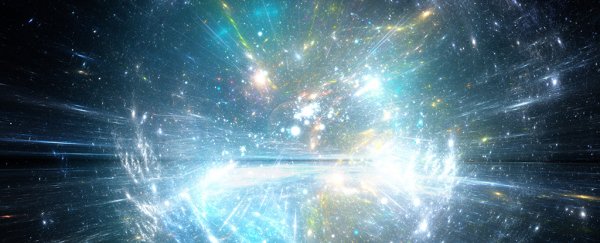A physicist from the University of Campinas in Brazil isn't a big fan of the idea that time started with a so-called Big Bang.
Instead, Juliano César Silva Neves imagines a collapse followed by an expansion, one that could even still carry the scars of a previous timeline.
The idea itself isn't new, but Neves has used a fifty-year-old mathematical trick describing black holes to show how our Universe needn't have had such a compact start to existence.
At first glance, our Universe doesn't seem to have a lot in common with black holes. One is expanding space full of clumpy bits; the other is mass pulling at space so hard that even light has no hope of escape.
But at the heart of both lies a concept known as a singularity – a volume of energy so infinitely dense, we can't even begin to explain what's going on inside it.
"There are two kinds of singularity in the Universe," says Neves.
"One is the alleged cosmological singularity, or Big Bang. The other hides behind the event horizon of a black hole."
Taken a step further, some propose the Universe itself formed from a black hole in some other bubble of space-time.
No matter which kind we're talking about, singularities are zones where Einstein's general relativity goes blind and quantum mechanics struggles to take over.
Sci-fi writers might love them, but the impossible nature of singularities makes them a frustrating point of contention among physicists.
The problem is, if we rewind the expanding Universe, we get to a point where all of that mass and energy was concentrated in an infinitely dense point. And if we crunch the numbers on collapsing massive objects, we get the same kind of thing.
Singularities might break physics, but so far we haven't been able to rule them out.
On the other hand, some physicists think there's some wiggle room. Theoretically speaking, not all models of a black hole need a singularity to exist.
"There are no singularities in so-called regular black holes," says Neves.
In 1968, a physicist by the name of James Bardeen came up with a solution to the singularity problem.
He devised a way of mathematically describing black holes that did away with the need for a singularity somewhere beyond its event horizon, calling them 'regular black holes'.
The history and reasoning behind Bardeen's model is, well, super dense; but for a tl;dr version – he assumed that the mass at the heart of a black hole needn't be constant, but could be described using a function that depended on how far from its centre you were.
That means we can dust our hands of any stupid singularities, as mass still behaves as if it has volume. Even as it is still squeezed into a tight space.
Neves suggests we take Bardeen's work even further and apply it to that other annoying singularity – the cosmological variety that preceded the Big Bang.
By assuming the rate of the Universe's expansion depended not just on time, but its scale as well, he showed there was no need for a quantum leap out of a singularity into a dense, voluminous space 13.82 billion years ago.
So what happened instead?
"Eliminating the singularity or Big Bang brings back the bouncing Universe on to the theoretical stage of cosmology," says Neves.
This 'bouncing Universe' is actually a century-old idea that the expanding Universe as we experience it today is space bouncing back outwards after a previous contraction.
Though it's currently somewhat of a fringe concept in cosmology, Neves supports the view that traces of the pre-collapse Universe might have survived the Big Crunch. If so, finding those scars might help validate the hypothesis.
"This image of an eternal succession of universes with alternating expansion and contraction phases was called the cyclical Universe, which derives from bouncing cosmologies," says Neves.
Until we have solid observations, the bouncing Universe model will no doubt stay in the 'nice idea' basket.
Still, anything that solves the singularity problem deserves investigating. Neves's work is just one of a number of possible solutions that swaps around assumptions to eliminate the need for physics-breaking impossibilities.
It's a sticking point we'll need to solve sooner or later.
This research was published in General Relativity and Gravitation.
